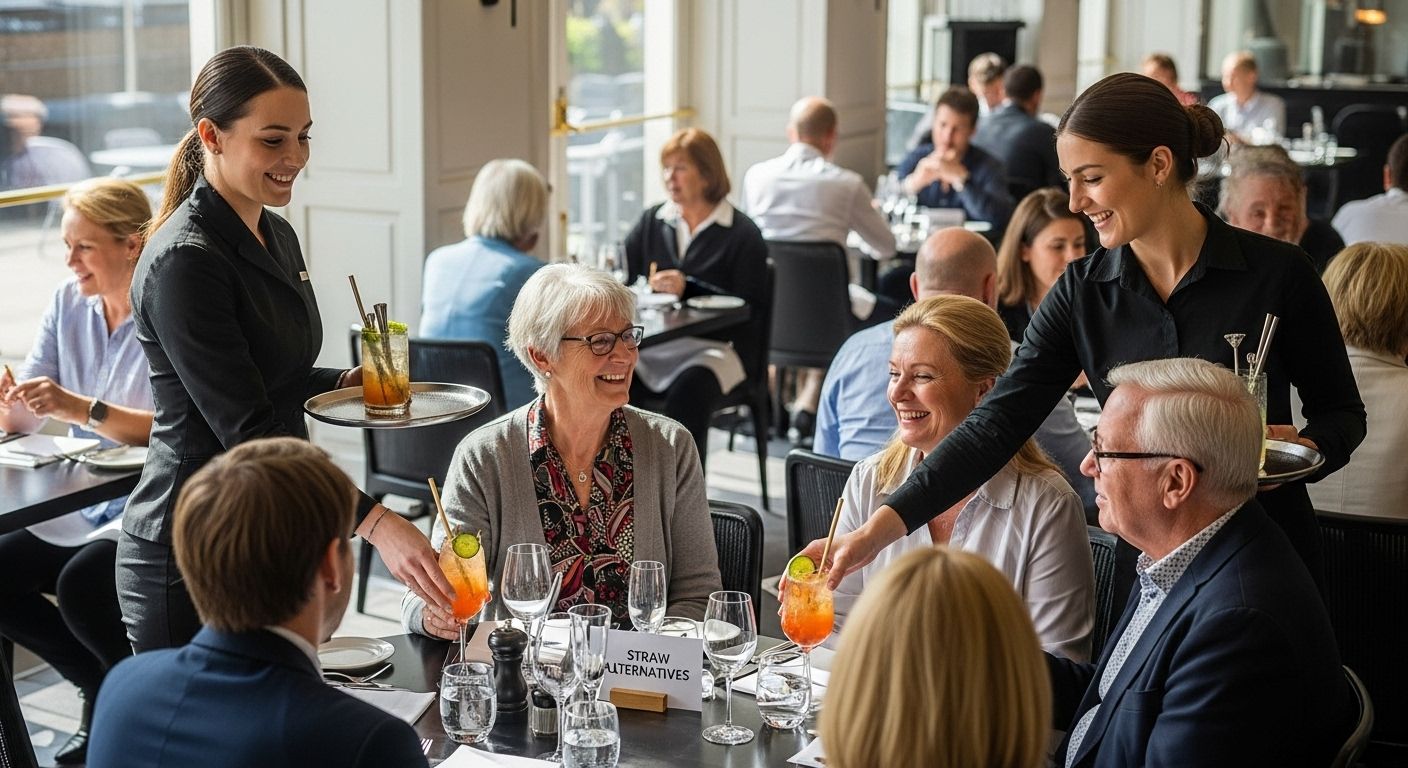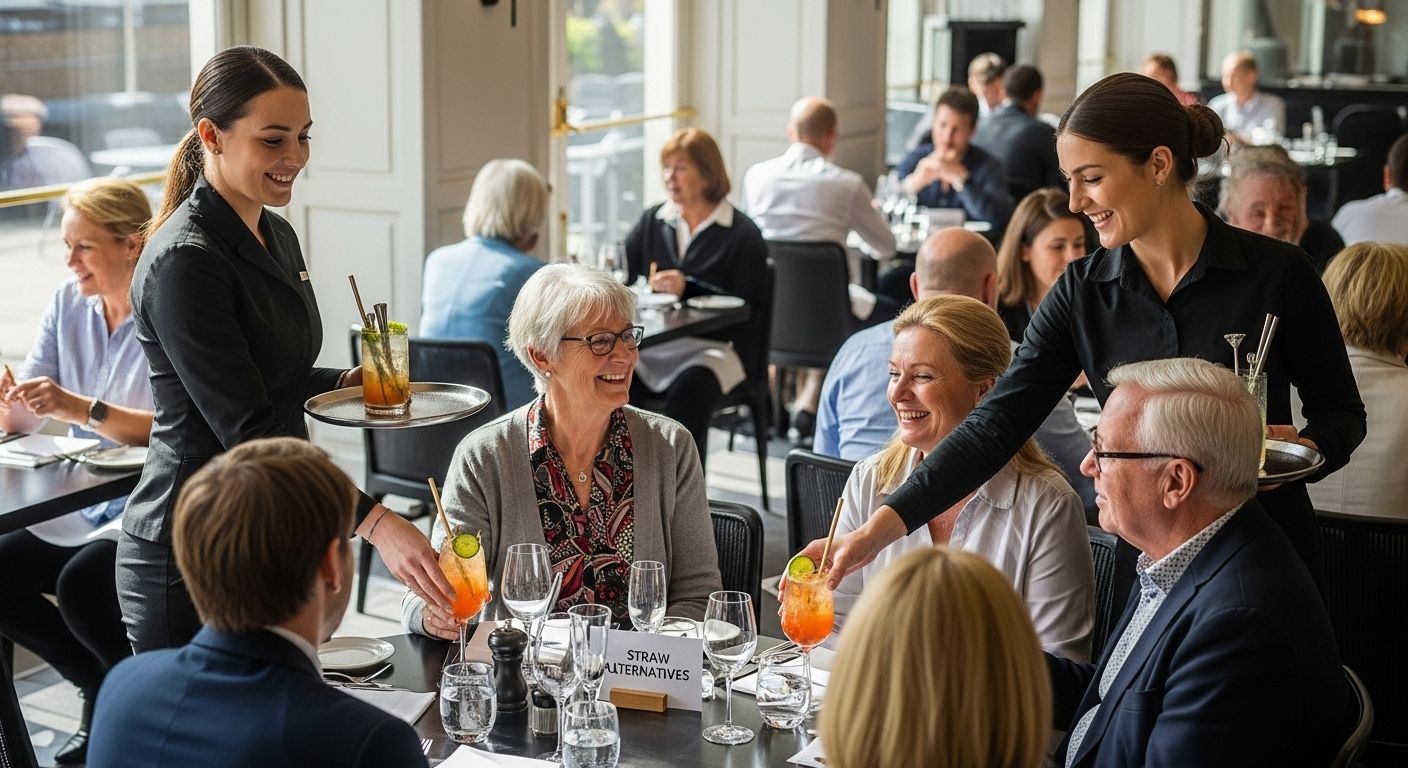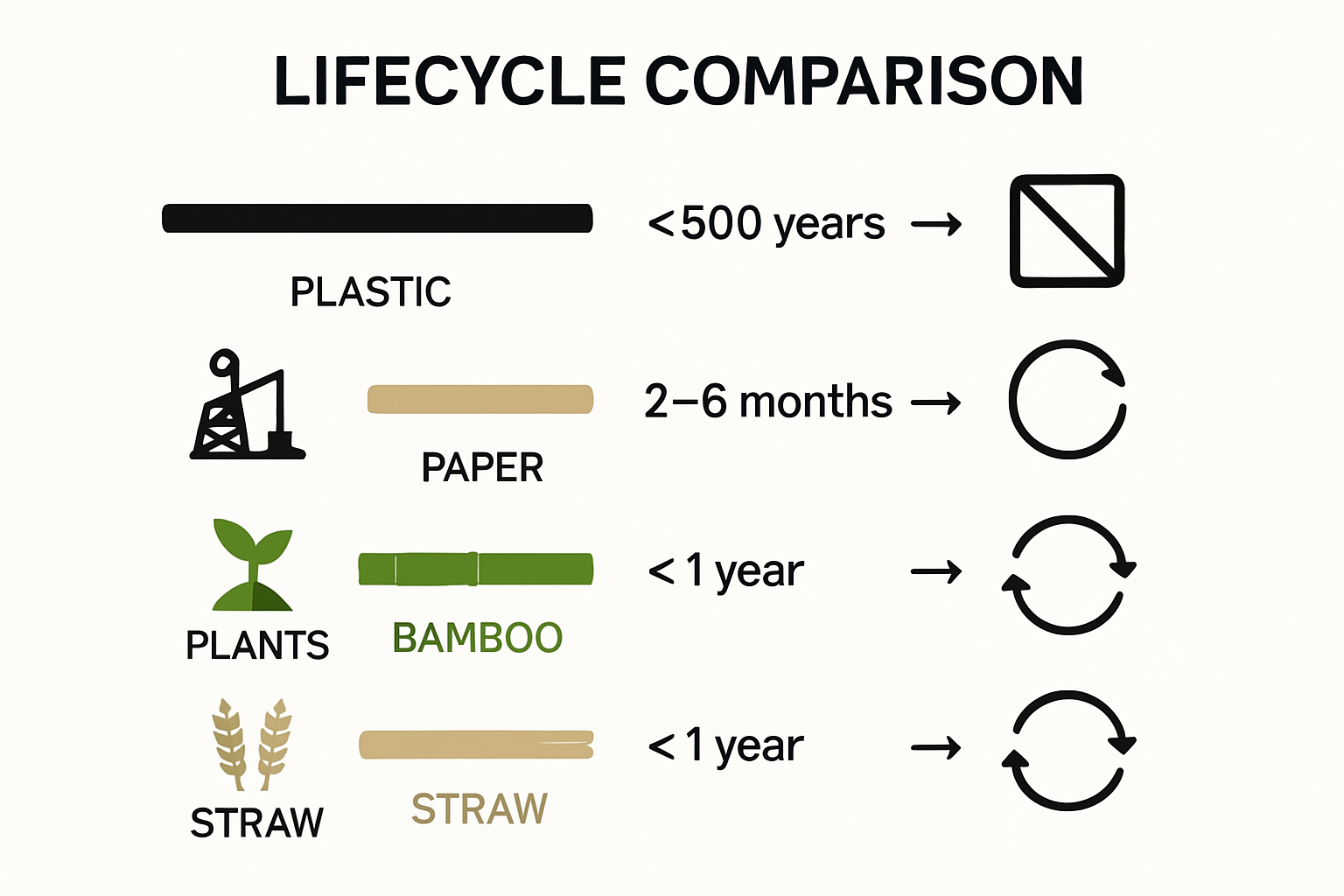Plastic Straw Alternatives for Hotels and Restaurants


Plastic straws seem harmless enough, right? Hotels and restaurants use about 500 million straws every single day in the US alone. That is a number so big it is hard to picture. Now get this. Most of those end up scattered across beaches or floating in the ocean for centuries. You might think switching to alternatives is a tiny gesture, but the real surprise is it can actually grow customer loyalty and set your business apart.
Table of Contents
- Why Choose Plastic Straw Alternatives
- Top Eco-Friendly Straw Options
- How To Select The Right Straw Solution
- Implementing Alternatives In Your Business
Quick Summary
| Takeaway | Explanation |
|---|---|
| Prioritize eco-friendly straw alternatives | Transitioning away from plastic straws is essential for sustainability in hospitality. |
| Consider customer preferences in selection | Choosing straws that enhance the drinking experience boosts customer satisfaction and loyalty. |
| Conduct a thorough impact assessment | Evaluate the full life cycle of straw materials to understand their environmental effects. |
| Invest in staff training for new products | Educating employees about alternatives helps them confidently communicate the changes to customers. |
| Develop a phased implementation plan | Gradually introducing straw alternatives minimizes disruptions while allowing for feedback and adjustments. |
Why Choose Plastic Straw Alternatives
The global movement away from plastic straws represents more than just an environmental trend. It is a critical response to the devastating ecological impact of single use plastics that have been polluting our oceans and harming marine ecosystems for decades.
Environmental Consequences of Plastic Straws
Plastic straws are a significant contributor to global waste problems. National Geographic reports that approximately 500 million plastic straws are used daily in the United States alone, with most ending up in landfills or waterways. These seemingly small items create massive environmental challenges.
Most plastic straws are made from polypropylene, a petroleum based plastic that does not biodegrade. Instead, they break down into microplastics that persist in the environment for hundreds of years. Ocean Conservancy estimates that these microplastics can take up to 500 years to decompose, causing long term damage to marine habitats and wildlife.
Economic and Reputation Benefits
Beyond environmental considerations, restaurants and hotels have compelling economic reasons to transition to plastic straw alternatives. Consumers increasingly prefer businesses that demonstrate environmental responsibility. Studies show that 66% of consumers are willing to pay more for sustainable products, making eco friendly choices a potential competitive advantage.
Implementing plastic straw alternatives signals a commitment to sustainability. This approach not only reduces environmental harm but also enhances a business reputation as a forward thinking, responsible organization. Guests and customers appreciate establishments that make conscious environmental choices, which can translate into increased customer loyalty and positive brand perception.
Moreover, many jurisdictions are implementing regulations that restrict or ban single use plastics. By proactively adopting sustainable alternatives, businesses can stay ahead of regulatory changes and avoid potential future compliance costs. This strategic approach demonstrates corporate social responsibility while protecting long term business interests.
Choosing plastic straw alternatives is no longer optional but a necessary step for responsible businesses in the hospitality and food service industries. The environmental, economic, and reputational benefits far outweigh the minimal cost of transitioning to sustainable solutions.
Top Eco-Friendly Straw Options
Restaurants and hotels seeking sustainable alternatives to plastic straws have an array of innovative options that balance environmental responsibility with practical functionality. The key is selecting materials that minimize ecological impact while meeting customer expectations for quality and user experience.
Below is a comparison table summarizing the key features, benefits, and considerations for each major category of eco-friendly straw alternatives discussed in the article. This table helps restaurants and hotels quickly evaluate the options for transitioning away from plastic straws.
| Straw Type | Key Benefits | Drawbacks/Considerations | Notable Features |
|---|---|---|---|
| Bamboo (Plant-Based) | Biodegradable, durable, natural aesthetic | May not suit all drink types | Made from renewable resource |
| Hay (Plant-Based) | Fully compostable, zero-waste | Can have limited durability | Made from agricultural byproducts |
| Metal (Reusable) | Highly durable, reusable multiple times | Requires cleaning protocols | Stainless steel, premium feel |
| Glass (Reusable) | Reusable, premium look, resists thermal shock | More fragile, needs special care | Made from borosilicate glass |
| Paper (Biodegradable) | Rapidly decomposes, improved structure | Can become soggy with extended use | Modern versions moisture-resistant |
| Cornstarch (Compostable) | Performs like plastic, fully compostable | Higher initial cost | Engineered plant-based material |
Natural Plant Based Straw Solutions
Natural plant based straws represent a promising frontier in sustainable dining accessories. The Alliance for the Chesapeake Bay highlights several compelling options that are both biodegradable and environmentally friendly. Bamboo straws emerge as a particularly attractive alternative, offering durability and a natural aesthetic that appeals to environmentally conscious consumers.
Hay straws provide another intriguing solution. Produced directly from agricultural byproducts, these straws are completely compostable and represent a zero waste approach to beverage service. Their natural origin means they break down quickly in composting environments, unlike traditional plastic straws that persist in ecosystems for centuries.
Reusable and Durable Alternatives
Metal straws have gained significant popularity among sustainability focused establishments. Stainless steel options offer exceptional durability and can be sanitized and reused multiple times. The U.S. Environmental Protection Agency recommends reusable products as an effective strategy for reducing single use plastics in food service settings.
Glass straws present another elegant reusable solution. While more fragile than metal alternatives, they provide a premium aesthetic that can enhance the dining experience. These straws are typically made from borosilicate glass, which offers superior resistance to thermal shock and potential breakage.
Biodegradable Engineered Straw Materials
Advanced biodegradable materials are revolutionizing sustainable straw production. Paper straws have evolved significantly, now offering improved structural integrity and moisture resistance. Modern paper straws can maintain their shape during use while still decomposing rapidly in environmental conditions.
Compostable straws made from plant based materials like cornstarch represent another cutting edge solution. These engineered materials provide performance comparable to traditional plastic straws while ensuring complete environmental decomposition. Restaurants can learn more about sustainable straw technologies that meet both ecological and operational requirements.
Selecting the right eco friendly straw involves considering multiple factors including environmental impact, cost, customer perception, and practical performance. Each alternative offers unique benefits, allowing hospitality businesses to make informed choices that align with their sustainability goals and customer expectations.
How to Select the Right Straw Solution
Selecting the ideal straw alternative requires a strategic approach that balances environmental responsibility, operational efficiency, and customer satisfaction. Hospitality businesses must carefully evaluate multiple factors to make an informed decision that aligns with their sustainability goals and practical requirements.
Assessing Environmental Impact
The National Park Service recommends a comprehensive approach to evaluating straw alternatives that goes beyond simple material selection. The full life cycle of a straw solution becomes critical in determining its true environmental value. This means considering not just the end of life disposal, but also the production process, transportation emissions, and overall ecological footprint.
Key environmental considerations include biodegradability, source of materials, and total carbon impact. Businesses should examine the complete journey of their chosen straw alternative. Straws made from rapidly renewable resources like bamboo or agricultural waste present significant advantages. These materials typically require less energy to produce and decompose more quickly than petroleum based alternatives.

Operational Practicality and Cost Analysis
Beyond environmental concerns, restaurants and hotels must carefully evaluate the practical performance of alternative straws. Material durability becomes a crucial factor. Some eco friendly options may compromise drinking experience or structural integrity. Metal straws offer exceptional durability but require additional cleaning protocols. Paper straws might become soggy with extended use, while plant based alternatives can vary in performance.
Cost remains a significant consideration for hospitality businesses. While sustainable alternatives may have a higher initial price point, long term benefits can offset these expenses. Reusable options like metal or glass straws reduce ongoing purchasing costs. Compostable alternatives might carry a premium but can enhance brand reputation and appeal to environmentally conscious consumers.
Customer Experience and Perception
The ultimate success of a straw alternative depends on customer acceptance and satisfaction. Different materials impact drinking experience significantly. Some customers may prefer the feel of metal straws, while others might find them uncomfortable. Biodegradable options must maintain structural integrity and not compromise the overall beverage enjoyment.
Presentation matters considerably in the hospitality industry. The visual and tactile qualities of straws contribute to the overall dining experience. Learn more about innovative straw solutions that balance aesthetics with sustainability. Establishments should consider how their chosen alternative reflects their brand values and commitment to environmental responsibility.
Making the right straw selection is not a one size fits all decision. It requires careful evaluation of environmental impact, operational constraints, cost considerations, and customer preferences. Successful implementation demands a holistic approach that considers the unique needs of each specific hospitality environment.
Implementing Alternatives in Your Business
Transitioning to plastic straw alternatives requires a strategic and comprehensive approach that goes beyond simply replacing existing straws. Successful implementation involves careful planning, staff training, customer communication, and a systematic rollout that ensures smooth operational integration.
The following table outlines suggested steps and actions for implementing plastic straw alternatives in a hospitality business, making it easier to visualize the phased approach and critical considerations described in the article.
| Step | Description | Key Actions |
|---|---|---|
| Internal Audit | Assess current straw use, waste, and costs | Gather usage data, identify improvement areas |
| Pilot Implementation | Start in select areas or with certain beverages | Test alternatives, collect feedback |
| Staff Training | Educate employees on products and sustainability benefits | Provide training, develop educational materials |
| Customer Communication | Share sustainability goals and straw options with customers | Table tents, menu notes, server explanations |
| Monitor & Adjust | Gather staff and customer feedback, refine roll-out | Make changes based on responses |
| Full Rollout | Launch alternatives across all operations once successful | Implement at scale, maintain communication |
Developing a Transition Strategy
Establishing a clear implementation plan is crucial for successfully introducing eco friendly straw alternatives. Begin by conducting an internal audit of current straw usage, waste generation, and potential cost implications. Harvard Business Review suggests creating a phased approach that allows for gradual adaptation and minimizes operational disruption.
Start by selecting a limited number of beverage types or service areas to pilot your new straw alternatives. This approach allows staff to become familiar with the new products and develop proper handling techniques. Track customer feedback, staff comfort level, and any operational challenges during this initial phase. Use these insights to refine your implementation strategy before a full scale rollout.
Staff Training and Engagement
Successful implementation hinges on comprehensive staff training and engagement. Employees must understand not just how to use the new straw alternatives, but also the environmental rationale behind the change. Sustainable Brands recommends creating educational materials that explain the environmental impact of traditional plastic straws and the benefits of alternatives.
Develop a training program that covers multiple aspects of the new straw solution. This should include proper handling, storage, potential hygiene considerations for reusable options, and how to discuss the change with customers. Engage staff by making them active participants in the sustainability journey. Consider creating incentive programs or recognition for staff members who effectively communicate and implement the new straw alternatives.
Customer Communication and Experience
Transparent and positive communication is key to helping customers embrace straw alternatives. Design clear messaging that explains your commitment to sustainability and the specific benefits of the new straw options. Learn more about communicating sustainable practices to effectively engage your customer base.
Consider creating informational materials that highlight the environmental impact of your choice. Table tents, menu notes, or brief server explanations can help customers understand and appreciate the change. Some businesses find success in offering customers the option to choose their preferred straw type, creating a sense of involvement and choice.
Monitor customer feedback carefully during the initial implementation phase. Be prepared to make adjustments based on customer responses while maintaining your core sustainability commitment. Some customers may require time to adapt to new drinking experiences, especially with alternative materials.

Implementing straw alternatives is more than a simple product swap. It represents a comprehensive approach to sustainability that requires thoughtful planning, staff commitment, and customer engagement. By approaching the transition strategically, businesses can successfully reduce environmental impact while potentially enhancing their brand reputation and customer loyalty.
Frequently Asked Questions
What are the environmental benefits of switching to plastic straw alternatives?
Switching to plastic straw alternatives helps reduce plastic pollution, as traditional plastic straws can take hundreds of years to decompose. Eco-friendly options, such as bamboo, metal, and paper straws, promote sustainability and significantly lessen the ecological footprint of restaurants and hotels.
How do I choose the right type of eco-friendly straw for my business?
Choosing the right eco-friendly straw involves assessing environmental impact, cost, durability, and customer experience. Consider the full life cycle of the straw materials and how they align with your business’s sustainability goals while meeting customer expectations for quality and usability.
What are some of the most common types of sustainable straws available?
Common types of sustainable straws include bamboo, metal, glass, paper, and plant-based straws like cornstarch. Each option has unique benefits, such as biodegradability, reusability, and overall performance, making it essential to consider which type best suits your establishment’s needs.
How can I effectively train my staff on using sustainable straw alternatives?
Effective training should include educating staff on the benefits of eco-friendly straws, proper handling techniques, and ways to communicate the changes to customers. Providing resources and engaging staff in the sustainability mission will help ensure a smooth transition to new straw alternatives.
Ready to Make a Real Change With Your Straw Choices?
You know your business wants to stand out by making eco-conscious decisions that matter. If you are struggling with the rising customer demand for sustainable solutions or worried about the negative impact of plastic waste mentioned throughout this article, you are not alone. The hospitality industry is transforming, and finding reliable plant-based or compostable straw options is more urgent than ever. Customers expect more, regulations are tightening, and the right straw can be a powerful symbol of your commitment to the planet.

Experience the difference by partnering with a trusted supplier of wood and plant-based, fully compostable straws. When you work with The Ocean Straw, you get eco-friendly straws that support both your operational needs and your sustainability goals. Visit our main site today to explore practical options for your hotel or restaurant. It is the right time to take a step forward for your business and the environment—transform your sustainability journey now.
Recommended
-
[
Hotellmagasinet – TOS Norway AS -
[
Waste Management in Hotels: Best Practices and Solutions – The Ocean Straw -
[
How Design Impacts Sustainability and the Customer Experience in Hospi – The Ocean Straw -
[
Introducing The Ocean Cup: The Sustainable Reusable Cup Changing HoReC – The Ocean Straw